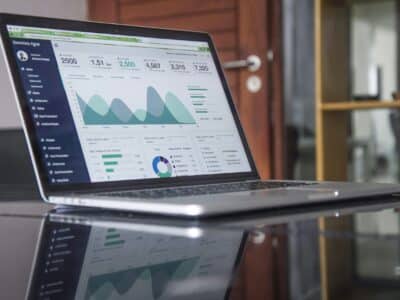Finance departments, CFOs, and Comptrollers at companies spend a lot of time generating reports and analyzing the information in them to gain insights. Financial reports allow institutions to mine insights from their data that give them visibility into a new understanding of their business. To generate deeper understanding on reporting platforms, companies need to merge or integrate financial data with other external data sets.
Many companies rely on out-of-the-box (OOB) reporting tools in accounting software supplemented with Excel spreadsheets. OOB reporting is the core of any accounting software, but these tools have a standard format and are difficult to customize.
For this reason, companies often use Excel spreadsheets for self-service reporting. However, Excel spreadsheets require a lot of manual labor. With spreadsheets, the process of accessing data and sharing information gets slowed down, and companies end up lacking a source of common knowledge.
Finance department team members build their own custom reporting platforms outside of accounting software to overcome the challenges of:
- Integrating external data to gain insights
- Customizing reports
- Overcoming inefficiency
- Collaborating and sharing data
Table of Contents
Integrating External and Financial Data
Using Excel to generate reports is a by-product of the limitations of OOB reporting.
Team members in finance departments started using Excel for several reasons. Accounting software does not always support custom or self-service reporting. If accounting software does offer self-service reporting, financial analysts often do not have the expertise or training required to use the reporting module properly. They also need a way to merge and integrate the data from finance software with other external data.
Finance departments must extract the information and put it into Excel spreadsheets so they can combine it with different data sets. However, this process of extracting and integrating data is time-consuming. While finance departments can use the export function to extract data, merging the data must be performed manually using formulas that they need to create themselves.
With a flexible reporting platform, finance departments have a means of extracting and integrating data automatically. By building their own reporting platform, finance departments gain the extensibility they need to accommodate future growth by improving and expanding.
Customized Reporting Platforms
Financial departments create their own reporting platforms because they must extract data and create custom reports for various purposes that go beyond the standard requests. Executives and investors need to receive data and reports in specific formats.
The OOB reports provided by accounting software are designed for a standard set of financial reports, such as balance sheet, aging report, and input statement. While incredibly useful, OOB reports often are not designed to answer specific questions or ad hoc requests that come up frequently within an organization.
Excel can be used to create custom reports, but it is inefficient. When finance departments use reports generated in Excel, insights from data can’t be distributed on a regular basis. If finance departments put data into Excel and use it to produce a report, the next month they need to go through the same process all over again.
An adaptable reporting platform is needed to ingest data and introduce efficiencies by eliminating manual steps. With a flexible reporting platform, data can be extracted and enriched to progress beyond canned reports. Reports can change with the evolving needs of the business.
Greater Efficiency
Finance departments must have access to real-time data sets to make accurate and profitable decisions for the company. Using Excel as a reporting tool slows down the process because data must be extracted and integrated manually. This increases the chance that data will be out of date or incomplete by the time the report is generated.
When financial departments create their own reporting platforms, they can extract and merge data from numerous sources, as well as allow data to be dispersed efficiently so the right financial decisions can be made. With an adaptable and flexible platform, reporting can be streamlined and automated for faster and more timely results. The reporting platform eliminates time-consuming manual steps by replacing them with automated workflows.
Collaboration and Data Sharing
With reports generated in Excel, financial departments lack a single source of truth for data that is needed for true collaboration and data sharing. Instead, every department has its own interpretation of data. Once the information has been put into Excel, data integrity has been lost.
With its own reporting platform, the business has a central, cloud-based source of financial data that can then be massaged and enriched for use in decision making. The platform can centralize one set of facts and interpretations so that everyone across the business is on the same page.
A flexible reporting platform allows a company to promote collaboration while preserving security and data quality. Data governance policies can be set that control access to financial data based on a department, group, or employee’s security level.
CONCLUSION: Building Your Own Reporting Platform
To gain the advantages of an adaptable reporting platform, your company can enlist the help of a partner with the expertise needed to build it. A technology partner can guide you in developing the platform and uncovering opportunities for customizing reports and automating processes.
dbSeer has considerable experience in the field of financial technology. We can create a modern architecture in the cloud that integrates data quickly. With our help, instead of taking months or years, a data integration project can be accomplished in weeks. We have the expertise needed to speed up the process.
Find out more about how to create your own reporting platform for finance. Contact dbSeer today.




